考研英语2010年真题新题型段落排序题解析与答案
2010考研英语真题答案(仅答案-完整)
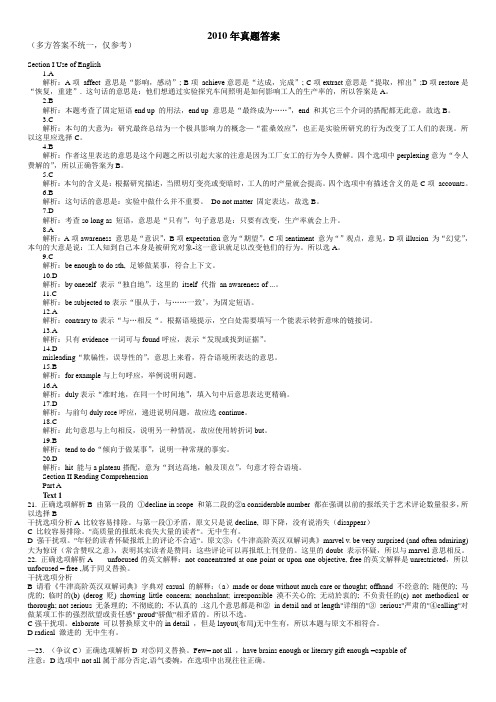
2010年真题答案(多方答案不统一,仅参考)Section I Use of English1.A解析:A项affect 意思是“影响,感动”; B项achieve意思是“达成,完成”; C项extract意思是“提取,榨出”;D项restore是“恢复,重建”. 这句话的意思是:他们想通过实验探究车间照明是如何影响工人的生产率的,所以答案是A。
2.B解析:本题考查了固定短语end up 的用法,end up 意思是“最终成为……”,end 和其它三个介词的搭配都无此意,故选B。
3.C解析:本句的大意为:研究最终总结为一个极具影响力的概念—“霍桑效应”,也正是实验所研究的行为改变了工人们的表现。
所以这里应选择C。
4.B解析:作者这里表达的意思是这个问题之所以引起大家的注意是因为工厂女工的行为令人费解。
四个选项中perplexing意为“令人费解的”,所以正确答案为B。
5.C解析:本句的含义是:根据研究描述,当照明灯变亮或变暗时,工人的时产量就会提高。
四个选项中有描述含义的是C项accounts。
6.B解析:这句话的意思是:实验中做什么并不重要。
Do not matter 固定表达,故选B。
7.D解析:考查so long as 短语,意思是“只有”,句子意思是:只要有改变,生产率就会上升。
8.A解析:A项awareness 意思是“意识”,B项expectation意为“期望”,C项sentiment 意为“”观点,意见,D项illusion 为“幻觉”,本句的大意是说:工人知到自己本身是被研究对象-这一意识就足以改变他们的行为。
所以选A。
9.C解析:be enough to do sth, 足够做某事,符合上下文。
10.D解析:by oneself 表示“独自地”,这里的itself 代指an awareness of ...。
11.C解析:be subjected to表示“服从于,与……一致’,为固定短语。
2010年考研英语真题及解析

2010年考研英语真题及解析考研英语对于众多学子来说,是通往研究生之路的重要关卡。
2010 年的考研英语真题具有一定的代表性和难度,下面我们就来一起深入探讨一下。
首先是英语知识运用部分,也就是我们常说的完形填空。
这部分主要考查考生对词汇、语法、固定搭配等基础知识的掌握以及对上下文的理解和逻辑推理能力。
2010 年的完形填空整体难度适中,所涉及的词汇和语法点较为常见,但需要考生在短时间内准确理解文意并做出选择。
比如其中有一道题考查了动词短语的搭配,需要考生根据上下文判断出最合适的短语。
这就要求考生平时对常见的动词短语有扎实的积累,并且能够灵活运用。
还有一些题目考查了逻辑连接词的选择,这需要考生清晰地把握文章的逻辑脉络,判断出前后句之间的关系是转折、递进还是因果等。
阅读理解部分一直是考研英语的重头戏。
2010 年的阅读理解文章题材广泛,涵盖了社会科学、自然科学、人文等多个领域。
这就要求考生具备较为广泛的知识背景和较强的阅读能力。
在这部分题目中,细节题、主旨题、推理题等各种题型均有出现。
细节题需要考生能够准确找到文章中的关键信息,并进行对比和分析;主旨题则要求考生能够从整体上把握文章的主旨大意;推理题则需要考生根据文章中的线索进行合理的推断。
比如其中一篇关于社会现象的文章,考生需要理解作者的观点和态度,并通过文中的细节来支持自己的判断。
还有一篇关于科学研究的文章,其中涉及到一些专业术语和复杂的实验过程,这对考生的阅读理解能力和专业知识储备都提出了挑战。
新题型部分也是考生需要重点关注的。
2010 年的新题型主要考查了段落排序和信息匹配。
段落排序题需要考生理清文章的逻辑结构和段落之间的关系,通过关键词、衔接词等线索来确定段落的顺序。
信息匹配题则要求考生快速浏览文章和选项,准确找到对应的信息。
翻译部分,2010 年的翻译题句子结构较为复杂,包含了较多的从句和长难词。
这就要求考生具备较强的语法分析能力和词汇量,能够准确地将英文句子翻译成通顺的中文。
2010年考研英语二真题全文翻译答案超详解析
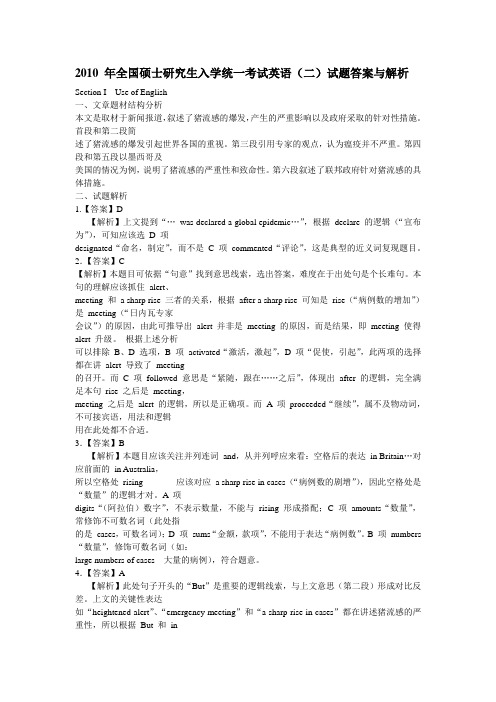
2010 年全国硕士研究生入学统一考试英语(二)试题答案与解析Section I Use of English一、文章题材结构分析本文是取材于新闻报道,叙述了猪流感的爆发,产生的严重影响以及政府采取的针对性措施。
首段和第二段简述了猪流感的爆发引起世界各国的重视。
第三段引用专家的观点,认为瘟疫并不严重。
第四段和第五段以墨西哥及美国的情况为例,说明了猪流感的严重性和致命性。
第六段叙述了联邦政府针对猪流感的具体措施。
二、试题解析1.【答案】D【解析】上文提到“…was declared a global epidemic…”,根据declare 的逻辑(“宣布为”),可知应该选D 项designated“命名,制定”,而不是C 项commented“评论”,这是典型的近义词复现题目。
2.【答案】C【解析】本题目可依据“句意”找到意思线索,选出答案,难度在于出处句是个长难句。
本句的理解应该抓住alert、meeting 和a sharp rise 三者的关系,根据after a sharp rise 可知是rise(“病例数的增加”)是meeting(“日内瓦专家会议”)的原因,由此可推导出alert 并非是meeting 的原因,而是结果,即meeting 使得alert 升级。
根据上述分析可以排除B、D 选项,B 项activated“激活,激起”,D 项“促使,引起”,此两项的选择都在讲alert 导致了meeting的召开。
而C 项followed 意思是“紧随,跟在……之后”,体现出after 的逻辑,完全满足本句rise 之后是meeting,meeting 之后是alert 的逻辑,所以是正确项。
而A 项proceeded“继续”,属不及物动词,不可接宾语,用法和逻辑用在此处都不合适。
3.【答案】B【解析】本题目应该关注并列连词and,从并列呼应来看:空格后的表达in Britain…对应前面的in Australia,所以空格处rising _____ 应该对应a sharp rise in cases(“病例数的剧增”),因此空格处是“数量”的逻辑才对。
2010年考研英语新题型详解
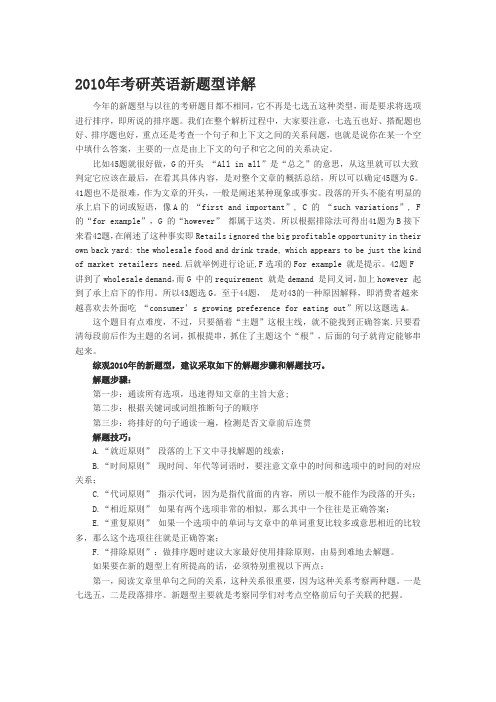
2010年考研英语新题型详解今年的新题型与以往的考研题目都不相同,它不再是七选五这种类型,而是要求将选项进行排序,即所说的排序题。
我们在整个解析过程中,大家要注意,七选五也好、搭配题也好、排序题也好,重点还是考查一个句子和上下文之间的关系问题,也就是说你在某一个空中填什么答案,主要的一点是由上下文的句子和它之间的关系决定。
比如45题就很好做,G的开头“All in all”是“总之”的意思,从这里就可以大致判定它应该在最后,在看其具体内容,是对整个文章的概括总结,所以可以确定45题为G。
41题也不是很难,作为文章的开头,一般是阐述某种现象或事实。
段落的开头不能有明显的承上启下的词或短语,像A的“first and important”, C 的“such variations”, F 的“for example”,G 的“however” 都属于这类。
所以根据排除法可得出41题为B接下来看42题,在阐述了这种事实即Retails ignored the big profitable opportunity in their own back yard: the wholesale food and drink trade, which appears to be just the kind of market retailers need.后就举例进行论证,F选项的For example 就是提示。
42题F讲到了wholesale demand,而G 中的requirement 就是demand 是同义词,加上however 起到了承上启下的作用。
所以43题选G。
至于44题,是对43的一种原因解释,即消费者越来越喜欢去外面吃“consumer’s growing preference for eating out”所以这题选A。
这个题目有点难度,不过,只要循着“主题”这根主线,就不能找到正确答案.只要看清每段前后作为主题的名词,抓根提串,抓住了主题这个“根”,后面的句子就肯定能够串起来。
考研英语真题分析之新题型
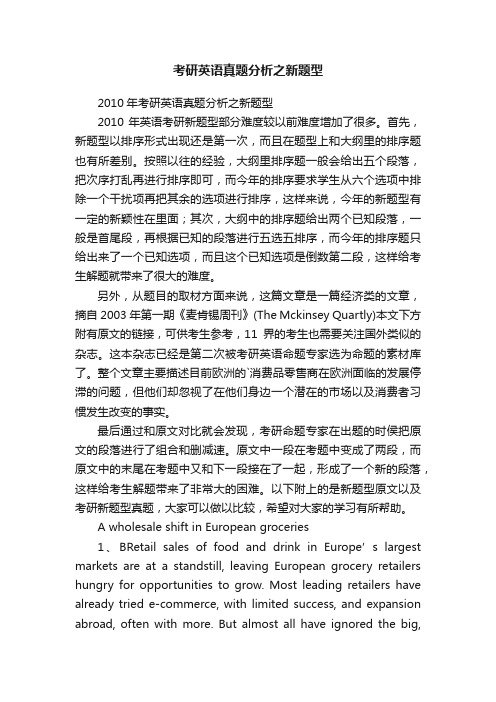
考研英语真题分析之新题型2010年考研英语真题分析之新题型2010年英语考研新题型部分难度较以前难度增加了很多。
首先,新题型以排序形式出现还是第一次,而且在题型上和大纲里的排序题也有所差别。
按照以往的经验,大纲里排序题一般会给出五个段落,把次序打乱再进行排序即可,而今年的排序要求学生从六个选项中排除一个干扰项再把其余的选项进行排序,这样来说,今年的新题型有一定的新颖性在里面;其次,大纲中的排序题给出两个已知段落,一般是首尾段,再根据已知的段落进行五选五排序,而今年的排序题只给出来了一个已知选项,而且这个已知选项是倒数第二段,这样给考生解题就带来了很大的难度。
另外,从题目的取材方面来说,这篇文章是一篇经济类的文章,摘自2003年第一期《麦肯锡周刊》(The Mckinsey Quartly)本文下方附有原文的链接,可供考生参考,11界的考生也需要关注国外类似的杂志。
这本杂志已经是第二次被考研英语命题专家选为命题的素材库了。
整个文章主要描述目前欧洲的`消费品零售商在欧洲面临的发展停滞的问题,但他们却忽视了在他们身边一个潜在的市场以及消费者习惯发生改变的事实。
最后通过和原文对比就会发现,考研命题专家在出题的时侯把原文的段落进行了组合和删减速。
原文中一段在考题中变成了两段,而原文中的末尾在考题中又和下一段接在了一起,形成了一个新的段落,这样给考生解题带来了非常大的困难。
以下附上的是新题型原文以及考研新题型真题,大家可以做以比较,希望对大家的学习有所帮助。
A wholesale shift in European groceries1、BRetail sales of food and drink in Europe’s largest markets are at a standstill, leaving European grocery retailers hungry for opportunities to grow. Most leading retailers have already tried e-commerce, with limited success, and expansion abroad, often with more. But almost all have ignored the big,profitable opportunity in their own backyard: the wholesale food and drink trade, which appears to be just the kind of market retailers need。
2010年考研英语真题及解析(1)
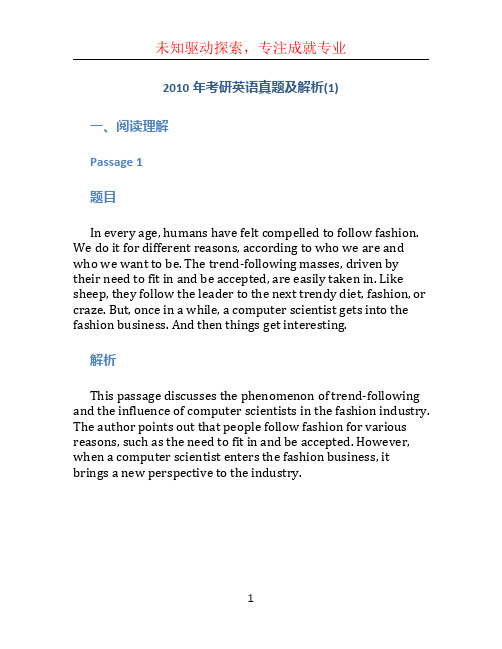
2010年考研英语真题及解析(1)一、阅读理解Passage 1题目In every age, humans have felt compelled to follow fashion. We do it for different reasons, according to who we are and who we want to be. The trend-following masses, driven by their need to fit in and be accepted, are easily taken in. Like sheep, they follow the leader to the next trendy diet, fashion, or craze. But, once in a while, a computer scientist gets into the fashion business. And then things get interesting.解析This passage discusses the phenomenon of trend-following and the influence of computer scientists in the fashion industry. The author points out that people follow fashion for various reasons, such as the need to fit in and be accepted. However, when a computer scientist enters the fashion business, it brings a new perspective to the industry.Passage 2题目It is often said that swimming is the best exercise. And rightly so. When you swim you use all the body’s muscles and you keep them working. Scientists and doctors say the advantages of swimming over exercising on land are many. One is that the water supports your body weight, so there is no strain on your joints and muscles. Working out in the water gives you even more muscle tone than exercising on land with the same amount of effort. Also, exercising in water is especially good for people with arthritis(关节炎) and muscular problems because the muscle resistance of the water helps to build up your muscles without pain or strain. So, even if you have been away from exercising for a long time or have health problems that prevent exercising on land, swimming is wonderful exercise.解析This passage discusses the benefits of swimming as an exercise. The author states that swimming utilizes all the body’s muscles and keeps them working. The water supports the body weight, reducing strain on the joints and muscles. Exercising in water also allows for more muscle tone compared to land exercises with the same effort. The author highlights that swimming is especially beneficial for people with arthritis and muscul ar problems because the water’s resistance helps build muscles without pain or strain.二、翻译原文China has a long history of tea drinking, tracing back to the Tang Dynasty more than 1,000 years ago. China is the largest producer and consumer of tea in the world. The Chinese tea ceremony is an important part of Chinese culture, emphasizing the art of preparing and serving tea. There are different types of Chinese tea, including green tea, black tea, oolong tea, and white tea. Each type has its unique flavor and health benefits. Green tea is known for its antioxidants and aiding in weight loss, while black tea is believed to improve heart health. Oolong tea is known for its distinctive fragrance and taste, and white tea is valued for its delicate flavor.解析茶叶饮用在中国有着悠久的历史,可以追溯到1000多年前的唐代。
2010年考研英语二阅读及新题型答案解析
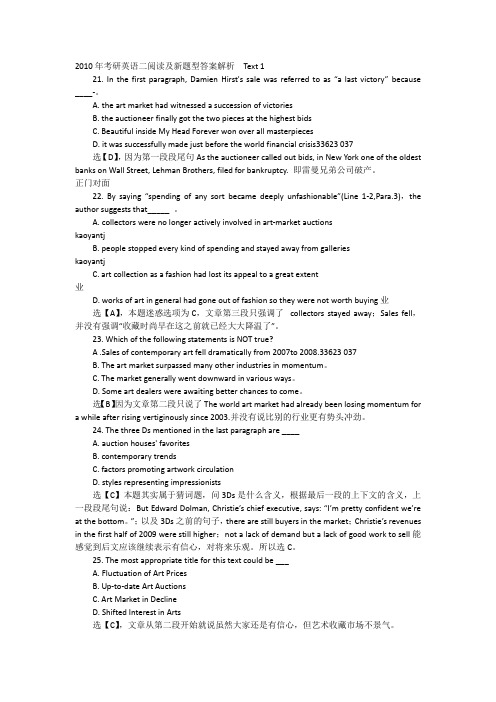
2010年考研英语二阅读及新题型答案解析Text 121. In the first paragraph, Damien Hirst's sale was referred to as “a last victory” because ____-。
A. the art market had witnessed a succession of victoriesB. the auctioneer finally got the two pieces at the highest bidsC. Beautiful inside My Head Forever won over all masterpiecesD. it was successfully made just before the world financial crisis33623 037选【D】,因为第一段段尾句As the auctioneer called out bids, in New York one of the oldest banks on Wall Street, Lehman Brothers, filed for bankruptcy. 即雷曼兄弟公司破产。
正门对面22. By saying “spending of any sort became deeply unfashionable”(Line 1-2,Para.3),the author suggests that_____ 。
A. collectors were no longer actively involved in art-market auctionskaoyantjB. people stopped every kind of spending and stayed away from gallerieskaoyantjC. art collection as a fashion had lost its appeal to a great extent业D. works of art in general had gone out of fashion so they were not worth buying业选【A】,本题迷惑选项为C,文章第三段只强调了 collectors stayed away;Sales fell,并没有强调“收藏时尚早在这之前就已经大大降温了”。
2010年考研英语真题参考答案
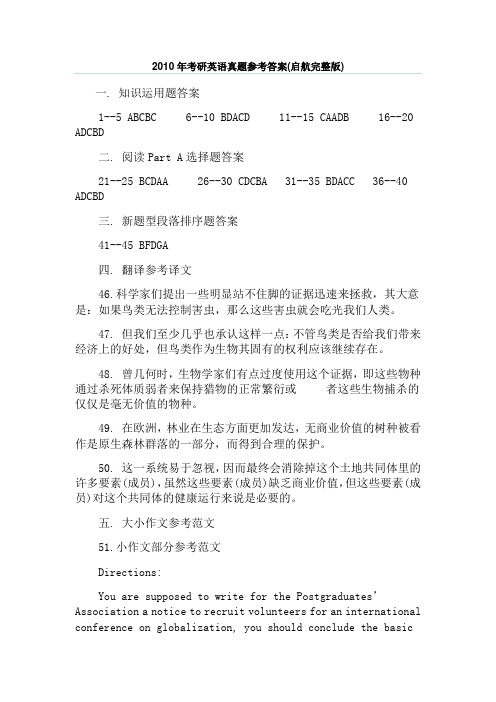
2010年考研英语真题参考答案(启航完整版)一. 知识运用题答案1--5 ABCBC 6--10 BDACD 11--15 CAADB 16--20 ADCBD二. 阅读Part A选择题答案21--25 BCDAA 26--30 CDCBA 31--35 BDACC 36--40 ADCBD三. 新题型段落排序题答案41--45 BFDGA四. 翻译参考译文46.科学家们提出一些明显站不住脚的证据迅速来拯救,其大意是:如果鸟类无法控制害虫,那么这些害虫就会吃光我们人类。
47. 但我们至少几乎也承认这样一点:不管鸟类是否给我们带来经济上的好处,但鸟类作为生物其固有的权利应该继续存在。
48. 曾几何时,生物学家们有点过度使用这个证据,即这些物种通过杀死体质弱者来保持猎物的正常繁衍或者这些生物捕杀的仅仅是毫无价值的物种。
49. 在欧洲,林业在生态方面更加发达,无商业价值的树种被看作是原生森林群落的一部分,而得到合理的保护。
50. 这一系统易于忽视,因而最终会消除掉这个土地共同体里的许多要素(成员),虽然这些要素(成员)缺乏商业价值,但这些要素(成员)对这个共同体的健康运行来说是必要的。
五. 大小作文参考范文51.小作文部分参考范文Directions:You are supposed to write for the Postgraduates’ Association a notice to recruit volunteers for an international conference on globalization, you should conclude the basic qualification of applicant and the other information you think relative。
You should write about 100 words. Do not sign your own name at the end of the letter. Use " Postgraduates’ Association " instead。
2010年考研英语真题及答案完整解析
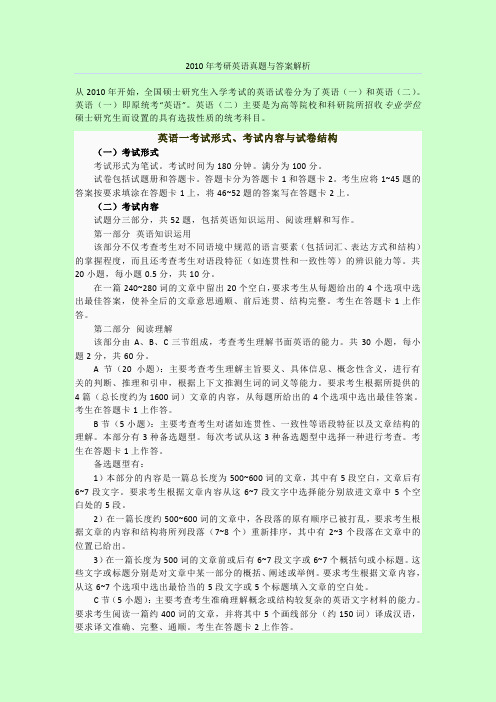
2010年考研英语真题与答案解析从2010年开始,全国硕士研究生入学考试的英语试卷分为了英语(一)和英语(二)。
英语(一)即原统考“英语”。
英语(二)主要是为高等院校和科研院所招收专业学位硕士研究生而设置的具有选拔性质的统考科目。
英语一考试形式、考试内容与试卷结构(一)考试形式考试形式为笔试。
考试时间为180分钟。
满分为100分。
试卷包括试题册和答题卡。
答题卡分为答题卡1和答题卡2。
考生应将1~45题的答案按要求填涂在答题卡1上,将46~52题的答案写在答题卡2上。
(二)考试内容试题分三部分,共52题,包括英语知识运用、阅读理解和写作。
第一部分英语知识运用该部分不仅考查考生对不同语境中规范的语言要素(包括词汇、表达方式和结构)的掌握程度,而且还考查考生对语段特征(如连贯性和一致性等)的辨识能力等。
共20小题,每小题0.5分,共10分。
在一篇240~280词的文章中留出20个空白,要求考生从每题给出的4个选项中选出最佳答案,使补全后的文章意思通顺、前后连贯、结构完整。
考生在答题卡1上作答。
第二部分阅读理解该部分由A、B、C三节组成,考查考生理解书面英语的能力。
共30小题,每小题2分,共60分。
A节(20小题):主要考查考生理解主旨要义、具体信息、概念性含义,进行有关的判断、推理和引申,根据上下文推测生词的词义等能力。
要求考生根据所提供的4篇(总长度约为1600词)文章的内容,从每题所给出的4个选项中选出最佳答案。
考生在答题卡1上作答。
B节(5小题):主要考查考生对诸如连贯性、一致性等语段特征以及文章结构的理解。
本部分有3种备选题型。
每次考试从这3种备选题型中选择一种进行考查。
考生在答题卡1上作答。
备选题型有:1)本部分的内容是一篇总长度为500~600词的文章,其中有5段空白,文章后有6~7段文字。
要求考生根据文章内容从这6~7段文字中选择能分别放进文章中5个空白处的5段。
2)在一篇长度约500~600词的文章中,各段落的原有顺序已被打乱,要求考生根据文章的内容和结构将所列段落(7~8个)重新排序,其中有2~3个段落在文章中的位置已给出。
2010年考研英语真题及解析
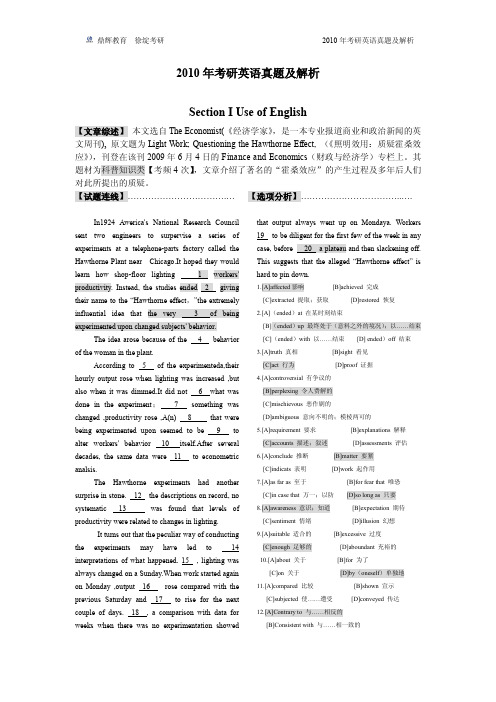
2010年考研英语真题及解析Section I Use of English【文章综述】本文选自The Economist(《经济学家》,是一本专业报道商业和政治新闻的英文周刊), 原文题为Light Work; Questioning the Hawthorne Effect,(《照明效用:质疑霍桑效应》),刊登在该刊2009年6月4日的Finance and Economics(财政与经济学)专栏上。
其题材为科普知识类【考频4次】,文章介绍了著名的“霍桑效应”的产生过程及多年后人们对此所提出的质疑。
【试题连线】…………………………….…【选项分析】……………………………..….In1924 Awerica's National Research Councilsent two engineers to surpervise a series ofexperiments at a telephone-parts factory called theHawthorne Plant near Chicago.It hoped they wouldlearn how shop-floor lightingworkers'productivity. Instead, thestudies ended givingtheir name to the “Hawthorne effect,”the extremely influential idea thatexperimented upon changed subjects' behavior.The idea arose because of the 4 behavior of the woman in the plant.According to 5 of the experimenteda,their hourly output rose when lighting was increased ,but also when it was dimmed.It did not 6 what was done in the experiment;7 something was changed ,productivity rose ,A(n) 8 that were being experimented upon seemed to be 9 to alter workers' behavior 10 itself.After several decades, the same data were 11 to econometric analsis.The Hawthorne experiments had another surprise in stone. 12 the descriptions on record, no systematic 13 was found that levels of productivity were related to changes in lighting.It turns out that the peculiar way of conducting the experiments may have led to 14 interpretations of what happened. 15 , lighting was always changed on a Sunday.When work started again on Monday ,output 16 rose compared with the previous Saturday and 17 to rise for the next couple of days. 18 , a comparison with data for weeks when there was no experimentation showed that output always went up on Mondaya. Workers 19to be diligent for the first few of the week in any case, beforeThis suggests that the alleged “Hawthorne effect” is hard to pin down.1.[A]affected影响[B]achieved 完成[C]extracted 提取;获取[D]restored 恢复2.[A](ended)at 在某时刻结束[B](ended)up 最终处于(意料之外的境况);以……结束[C](ended)with 以……结束[D] ended)off 结束3.[A]truth 真相[B]sight 看见[C]act 行为[D]proof 证据4.[A]controversial 有争议的[B]perplexing 令人费解的[C]mischievous 恶作剧的[D]ambiguous 意向不明的;模棱两可的5.[A]requirement 要求[B]explanations 解释[C]accounts 描述;叙述[D]assessments 评估6.[A]conclude 推断[B]matter 要紧[C]indicats 表明[D]work 起作用7.[A]as far as 至于[B]for fear that 唯恐[C]in case that 万一;以防[D]so long as 只要8.[A]awareness 意识;知道[B]expectation 期待[C]sentiment 情绪[D]illusion 幻想9.[A]suitable 适合的[B]excessive 过度[C]enough 足够的[D]aboundant 充裕的10.[A]about 关于[B]for 为了[C]on 关于[D]by(oneself)单独地11.[A]compared 比较[B]shown 宣示[C]subjected 使……遭受[D]conveyed 传达12.[A]Contrary to 与……相反的[B]Consistent with 与……相一致的[C]Parallel with 与…相应的[D]Peculiar to 特有的13.[A]evidence 证据[B]guidance 指导[C]implication 暗示;可能的影响(或结果)[D]source 来源14.[A]disputable 有争议的[B]enlightening 给人启迪的[C]reliable 可信的[D]misleading 误导的15.[A]In contrast 相比之下[B]For example 例如[C]In consequence 结果是;因此[D]As usual 像平常一样16.[A]duly 适当地;按时地[B]accidentally 偶然地[C]unpredictably 变幻莫测的[D]suddenly 突然地17.[A]failed(to do)未能做[B]ceased(to do)停止做[C]started(to do)开始做[D]continued(to do)继续做18.[A]Therefore 因此[B]Furthermore 此外;而且[C]However 然而[D]Meanwhile 同时19.[A]attempted(to do)试图做[B]tended(to do)往往会[C]chose(to do)选择做[D]intended(to do)打算做20.[A]breaking 打破;突破[B]climbing 攀升[C]surpassing 超过[D]hitting 达到【核心词汇】allege [əˈledʒ] v.断言,宣称;指控,辩解(al表强调+lege→表强调讲→宣称);-ed,adj. 声称的;所谓的arise[ə^raiz]v.发生;产生;出现influential[influ^en∫l]adj. 有影响的interpretation[inʌtЗ:pri^tei∫] n.解释;说明plateau[ˈplætəu]n.高原,(发展、增长后的)平稳状态(时期);停滞时期(plat+eau名词后缀→平坦地)slack[slAk]a.懈怠的,松弛的;萧条的n.淡季;(pl.)便裤;-en,v.使松弛,使萧条surpervise [^su:pəvaiz]v. 监督;管理;指导systematic[sisti5mAtik]a.(systematical)系统的,有组织的,成体系的,有规律的;-ic,人或学科(表名词)【超纲词汇】duly[ˈdu:li] adv. 1. 正确地, 适当地,恰当的2. 按时地, 准时地,适时地shop-floor[∫op^flʌ:(r)]n.车间;工厂【常用词组】experiment on/upon 用………做实验give one’s name to以……的名字命名(新生的)事物go up(价格、水平等)上涨;上升;增长in store(for sb) 1. 储备着, 贮藏着2. 将要发生, 就要出现on record有记载的, 记录在案的, 公开发表的pin down 1. 把…固定住; 使动弹不得2. 迫使作出决定, 采取行动slacken off 松懈下来;减缓turn out 结果(是);原来(是)【答案与详解】1.答案→A 考点→上下文关系与动词词义辨析。
2010年考研英语真题(含答案解析)
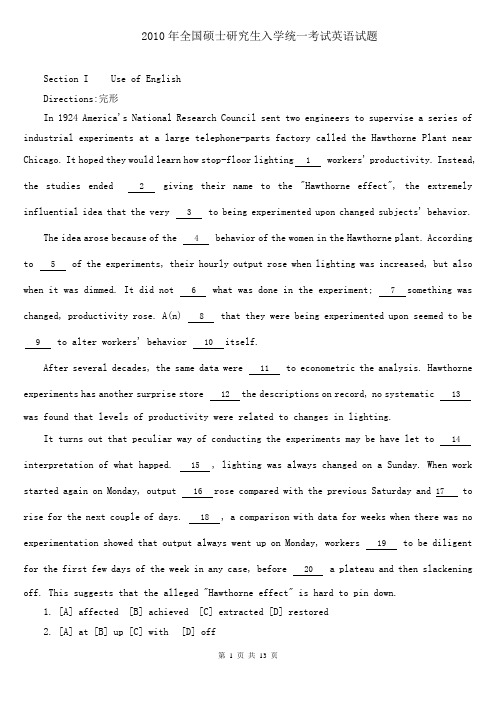
2010年全国硕士研究生入学统一考试英语试题Section I Use of EnglishDirections:完形In 1924 America's National Research Council sent two engineers to supervise a series of industrial experiments at a large telephone-parts factory called the Hawthorne Plant near Chicago. It hoped they would learn how stop-floor lighting1 workers' productivity. Instead, the studies ended 2 giving their name to the "Hawthorne effect", the extremely influential idea that the very 3 to being experimented upon changed subjects' behavior.The idea arose because of the 4 behavior of the women in the Hawthorne plant. According to 5 of the experiments, their hourly output rose when lighting was increased, but also when it was dimmed. It did not 6 what was done in the experiment; 7something was changed, productivity rose. A(n) 8 that they were being experimented upon seemed to be9 to alter workers' behavior 10itself.After several decades, the same data were 11 to econometric the analysis. Hawthorne experiments has another surprise store 12the descriptions on record, no systematic 13was found that levels of productivity were related to changes in lighting.It turns out that peculiar way of conducting the experiments may be have let to 14 interpretation of what happed. 15, lighting was always changed on a Sunday. When work started again on Monday, output 16rose compared with the previous Saturday and 17 to rise for the next couple of days. 18, a comparison with data for weeks when there was no experimentation showed that output always went up on Monday, workers 19 to be diligent for the first few days of the week in any case, before 20 a plateau and then slackening off. This suggests that the alleged "Hawthorne effect" is hard to pin down.1. [A] affected [B] achieved [C] extracted [D] restored2. [A] at [B] up [C] with [D] off3. [A] truth [B] sight [C] act [D] proof4. [A] controversial [B] perplexing [C] mischievous [D] ambiguous5. [A] requirements [B] explanations [C] accounts [D] assessments6. [A] conclude [B] matter [C] indicate [D] work7. [A] as far as [B] for fear that [C] in case that [D] so long as8. [A] awareness [B] expectation [C] sentiment [D] illusion9. [A] suitable [B] excessive [C] enough [D] abundant10. [A] about [B] for [C] on [D] by11. [A] compared [B] shown [C] subjected [D] conveyed12. [A] contrary to [B] consistent with [C] parallel with [D] peculiar to13. [A] evidence [B] guidance [C] implication [D] source14. [A] disputable [B] enlightening [C] reliable [D] misleading15. [A] In contrast [B] For example [C] In consequence [D] As usual16. [A] duly [B] accidentally [C] unpredictably [D] suddenly17. [A] failed [B] ceased [C] started [D] continued20. [A] breaking [B] climbing [C] surpassing [D] hittingSection II Reading ComprehensionText 1Of all the changes that have taken place in English-language newspapers during the past quarter-century, perhaps the most far-reaching has been the inexorable decline in the scope and seriousness of their arts coverage.It is difficult to the point of impossibility for the average reader under the age of forty to imagine a time when high-quality arts criticism could be found in most big-city newspapers. Yet a considerable number of the most significant collections of criticism published in the 20th century consisted in large part of newspaper reviews. To read such books today is to marvel at the fact that their learned contents were once deemed suitable for publication in general-circulation dailies.We are even farther removed from the unfocused newspaper reviews published in England between the turn of the 20th century and the eve of World War II, at a time when newsprint was dirt-cheap and stylish arts criticism was considered an ornament to the publications in which it appeared. In those far-off days, it was taken for granted that the critics of major papers would write in detail and at length about the events they covered. Theirs was a seriousbusiness, and even those reviewers who wore their learning lightly, like George Bernard Shaw and Ernest Newman, could be trusted to know what they were about. These men believed in journalism as a calling, and were proud to be published in the daily press. “So few authors have brains enough or literary gift enough to keep the ir own end up in journalism,” Newman wrote, “that I am tempted to define ‘journalism’ as ‘a term of contempt applied by writers who are not read to writers who are.’”Unfortunately, these critics are virtually forgotten. Neville Cardus, who wrote for the Manchester Guardian from 1917 until shortly before his death in 1975, is now known solely as a writer of essays on the game of cricket. During his lifetime, though, he was also one of England’s foremost classical-music critics, a stylist so widely admired that his Autobiography (1947) became a best-seller. He was knighted in 1967, the first music critic to be so honored. Yet only one of his books is now in print, and his vast body of writings on music is unknown save to specialists.Is there any chance that Cardus’s criticism will enjoy a revival? The prospect seems remote. Journalistic tastes had changed long before his death, and postmodern readers have little use for the richly upholstered Vicwardian prose in which he specialized. Moreover, the amateur tradition in music criticism has been in headlong retreat.21. It is indicated in Paragraphs 1 and 2 that[A] arts criticism has disappeared from big-city newspapers.[B] English-language newspapers used to carry more arts reviews.[C] high-quality newspapers retain a large body of readers.[D] young readers doubt the suitability of criticism on dailies.22. Newspaper reviews in England before World War II were characterized by[A] free themes.[B] casual style.[C] elaborate layout.[D] radical viewpoints.23. Which of the following would Shaw and Newman most probably agree on?[A] It is writers' duty to fulfill journalistic goals.[B] It is contemptible for writers to be journalists.[C] Writers are likely to be tempted into journalism.[D] Not all writers are capable of journalistic writing.24. What can be learned about Cardus according to the last two paragraphs?[A] His music criticism may not appeal to readers today.[B] His reputation as a music critic has long been in dispute.[C] His style caters largely to modern specialists.[D] His writings fail to follow the amateur tradition.25. What would be the best title for the text?[A] Newspapers of the Good Old Days[B] The Lost Horizon in Newspapers[C] Mournful Decline of Journalism[D] Prominent Critics in MemoryText 2Over the past decade, thousands of patents have been granted for what are called business methods. received one for its "one-click" online payment system. Merrill Lynch got legal protection for an asset allocation strategy. One inventor patented a technique for lifting a box.Now the nation's top patent court appears completely ready to scale back on business-method patents, which have been controversial ever since they were first authorized 10 years ago. In a move that has intellectual-property lawyers abuzz the U.S. court of Appeals for the federal circuit said it would use a particular case to conduct a broad review of business-method patents. In re Bilski, as the case is known , is "a very big deal", says Dennis D. Crouch of the University of Missouri School of law. It "has the potential to eliminate an entire class of patents."Curbs on business-method claims would be a dramatic about-face, because it was the federal circuit itself that introduced such patents with is 1998 decision in the so-called state Street Bank case, approving a patent on a way of pooling mutual-fund assets. That ruling produced an explosion in business-method patent filings, initially by emerging internet companies trying to stake out exclusive rights to specific types of online transactions. Later, move established companies raced to add such patents to their files, if only as a defensive move against rivals that might beat them to the punch. In 2005, IBM noted in a court filing that it had been issued more than 300 business-method patents despite the fact that it questioned the legal basis for granting them. Similarly, some Wall Street investment films armed themselves with patents for financial products, even as they took positions in court cases opposing the practice.The Bilski case involves a claimed patent on a method for hedging risk in the energy market.The Federal circuit issued an unusual order stating that the case would be heard by all 12 of the court's judges, rather than a typical panel of three, and that one issue it wants to evaluate is whether it should "reconsider" its state street Bank ruling.The Federal Circuit's action comes in the wake of a series of recent decisions by the supreme Court that has narrowed the scope of protections for patent holders. Last April, for example the justices signaled that too many patents were being upheld for "inventions" that are obvious. The judges on the Federal circuit are "reacting to the anti-patent trend at the Supreme Court", says Harold C. Wegner, a patent attorney and professor at George Washington University Law School.26. Business-method patents have recently aroused concern because of[A] their limited value to business[B] their connection with asset allocation[C] the possible restriction on their granting[D] the controversy over authorization27. Which of the following is true of the Bilski case?[A] Its ruling complies with the court decisions[B] It involves a very big business transaction[C] It has been dismissed by the Federal Circuit[D] It may change the legal practices in the U.S.28. The word "about-face" (Line 1, Para 3) most probably means[A] loss of good will[B] increase of hostility[C] change of attitude[D] enhancement of dignity29. We learn from the last two paragraphs that business-method patents[A] are immune to legal challenges[B] are often unnecessarily issued[C] lower the esteem for patent holders[D] increase the incidence of risks30. Which of the following would be the subject of the text?[A] A looming threat to business-method patents[B] Protection for business-method patent holders[C] A legal case regarding business-method patents[D] A prevailing trend against business-method patentsText 3In his book The Tipping Point, Malcolm Gladwell argues that social epidemics are driven in large part by the acting of a tiny minority of special individuals, often called influentials, who are unusually informed, persuasive, or well-connected. The idea is intuitively compelling, but it doesn't explain how ideas actually spread.The supposed importance of influentials derives from a plausible sounding but largely untested theory called the "two step flow of communication": Information flows from the media to the influentials and from them to everyone else. Marketers have embraced the two-step flow because it suggests that if they can just find and influence the influentials, those selected people will do most of the work for them. The theory also seems to explain the sudden and unexpected popularity of certain looks, brands, or neighborhoods. In many such cases, a cursory search for causes finds that some small group of people was wearing, promoting, or developing whatever it is before anyone else paid attention. Anecdotal evidence of this kind fits nicely with the idea that only certain special people can drive trendsIn their recent work, however, some researchers have come up with the finding that influentials have far less impact on social epidemics than is generally supposed. In fact, they don't seem to be required of all.The researchers' argument stems from a simple observing about social influence, with the exception of a few celebrities like Oprah Winfrey—whose outsize presence is primarily a function of media, not interpersonal, influence—even the most influential members of a population simply don't interact with that many others. Yet it is precisely these non-celebrity influentials who, according to the two-step-flow theory, are supposed to drive social epidemics by influencing their friends and colleagues directly. For a social epidemic to occur, however, each person so affected, must then influence his or her own acquaintances, who must in turn influence theirs, and so on; and just how many others pay attention to each of these people has little to do with the initial influential. If people in the network just two degrees removed from the initial influential prove resistant, for example from the initial influential prove resistant, for example the cascade of change won't propagate very far or affect many people.Building on the basic truth about interpersonal influence, the researchers studied the dynamics of populations manipulating a number of variables relating of populations,manipulating a number of variables relating to people's ability to influence others and their tendency to be influenced. Our work shows that the principal requirement for what we call "global cascades"– the widespread propagation of influence through networks – is the presence not of a few influentials but, rather, of a critical mass of easily influenced people, each of whom adopts, say, a look or a brand after being exposed to a single adopting neighbor. Regardless of how influential an individual is locally, he or she can exert global influence only if this critical mass is available to propagate a chain reaction.31. By citing the book The Tipping Point, the author intends to[A] analyze the consequences of social epidemics[B] discuss influentials' function in spreading ideas[C] exemplify people's intuitive response to social epidemics[D] describe the essential characteristics of influentials.32. The author suggests that the "two-step-flow theory"[A] serves as a solution to marketing problems[B] has helped explain certain prevalent trends[C] has won support from influentials[D] requires solid evidence for its validity33. What the researchers have observed recently shows that[A] the power of influence goes with social interactions[B] interpersonal links can be enhanced through the media[C] influentials have more channels to reach the public[D] most celebrities enjoy wide media attention34. The underlined phrase "these people" in paragraph 4 refers to the ones who[A] stay outside the network of social influence[B] have little contact with the source of influence[C] are influenced and then influence others[D] are influenced by the initial influential35. what is the essential element in the dynamics of social influence?[A] The eagerness to be accepted[B] The impulse to influence others[C] The readiness to be influenced[D] The inclination to rely on othersText 4Bankers have been blaming themselves for their troubles in public. Behind the scenes, they have been taking aim at someone else: the accounting standard-setters. Their rules, moan the banks, have forced them to report enormous losses, and it's just not fair. These rules say they must value some assets at the price a third party would pay, not the price managers and regulators would like them to fetch.Unfortunately, banks' lobbying now seems to be working. The details may be unknowable, but the independence of standard-setters, essential to the proper functioning of capital markets, is being compromised. And, unless banks carry toxic assets at prices that attract buyers, reviving the banking system will be difficult.After a bruising encounter with Congress, America's Financial Accounting Standards Board (FASB) rushed through rule changes. These gave banks more freedom to use models to value illiquid assets and more flexibility in recognizing losses on long-term assets in their income statement. Bob Herz, the FASB's chairman, cried out against those who "question our motives." Yet bank shares rose and the changes enhance what one lobby group politely calls "the use of judgment by management."European ministers instantly demanded that the International Accounting Standards Board (IASB) do likewise. The IASB says it does not want to act without overall planning, but the pressure to fold when it completes it reconstruction of rules later this year is strong. Charlie McCreevy, a European commissioner, warned the IASB that it did "not live in a political vacuum" but "in the real word" and that Europe could yet develop different rules.It was banks that were on the wrong planet, with accounts that vastly overvalued assets. Today they argue that market prices overstate losses, because they largely reflect the temporary illiquidity of markets, not the likely extent of bad debts. The truth will not be known for years. But bank's shares trade below their book value, suggesting that investors are skeptical. And dead markets partly reflect the paralysis of banks which will not sell assets for fear of booking losses, yet are reluctant to buy all those supposed bargains.To get the system working again, losses must be recognized and dealt with. America's new plan to buy up toxic assets will not work unless banks mark assets to levels which buyers find attractive. Successful markets require independent and even combative standard-setters. The FASB and IASB have been exactly that, cleaning up rules on stock options and pensions, for example, against hostility from special interests. But by giving in to critics now they areinviting pressure to make more concessions.36. Bankers complained that they were forced to[A] follow unfavorable asset evaluation rules[B] collect payments from third parties[C] cooperate with the price managers[D] reevaluate some of their assets.37. According to the author , the rule changes of the FASB may result in[A] the diminishing role of management[B] the revival of the banking system[C] the banks' long-term asset losses[D] the weakening of its independence38. According to Paragraph 4, McCreevy objects to the IASB's attempt to[A] keep away from political influences.[B] evade the pressure from their peers.[C] act on their own in rule-setting.[D] take gradual measures in reform.39. The author thinks the banks were "on the wrong planet" in that they[A] misinterpreted market price indicators[B] exaggerated the real value of their assets[C] neglected the likely existence of bad debts.[D] denied booking losses in their sale of assets.40. The author's attitude towards standard-setters is one of[A] satisfaction.[B] skepticism.[C] objectiveness[D] sympathyPart BDirections:选段排序[A] The first and more important is the consumer's growing preference for eating out; the consumption of food and drink in places other than homes has risen from about 32 percent of total consumption in 1995 to 35 percent in 2000 and is expected to approach 38 percent by 2005. This development is boosting wholesale demand from the food service segment by 4 to 5 percenta year across Europe, compared with growth in retail demand of 1 to 2 percent. Meanwhile, as the recession is looming large, people are getting anxious. They tend to keep a tighter hold on their purse and consider eating at home a realistic alternative.[B] Retail sales of food and drink in Europe's largest markets are at a standstill, leaving European grocery retailers hungry for opportunities to grow. Most leading retailers have already tried e-commerce, with limited success, and expansion abroad. But almost all have ignored the big, profitable opportunity in their own backyard: the wholesale food and drink trade, which appears to be just the kind of market retailers need.[C] Will such variations bring about a change in the overall structure of the food and drink market? Definitely not. The functioning of the market is based on flexible trends dominated by potential buyers. In other words, it is up to the buyer, rather than the seller, to decide what to buy .At any rate, this change will ultimately be acclaimed by an ever-growing number of both domestic and international consumers, regardless of how long the current consumer pattern will take hold.[D] All in all, this clearly seems to be a market in which big retailers could profitably apply their scale, existing infrastructure and proven skills in the management of product ranges, logistics, and marketing intelligence. Retailers that master the intricacies of wholesaling in Europe may well expect to rake in substantial profits thereby. At least, that is how it looks as a whole. Closer inspection reveals important differences among the biggest national markets, especially in their customer segments and wholesale structures, as well as the competitive dynamics of individual food and drink categories. Big retailers must understand these differences before they can identify the segments of European wholesaling in which their particular abilities might unseat smaller but entrenched competitors. New skills and unfamiliar business models are needed too.[E] Despite variations in detail, wholesale markets in the countries that have been closely examined—France, Germany, Italy, and Spain—are made out of the same building blocks. Demand comes mainly from two sources: independent mom-and-pop grocery stores which, unlike large retail chains, are two small to buy straight from producers, and food service operators that cater to consumers when they don't eat at home. Such food service operators range from snack machines to large institutional catering ventures, but most of these businesses are known in the trade as "horeca": hotels, restaurants, and cafes. Overall, Europe's wholesale market for food and drink is growing at the same sluggish pace as the retail market, but the figures,when added together, mask two opposing trends.[F] For example, wholesale food and drink sales come to $268 billion in France, Germany, Italy, Spain, and the United Kingdom in 2000—more than 40 percent of retail sales. Moreover, average overall margins are higher in wholesale than in retail; wholesale demand from the food service sector is growing quickly as more Europeans eat out more often; and changes in the competitive dynamics of this fragmented industry are at last making it feasible for wholesalers to consolidate.[G] However, none of these requirements should deter large retailers (and even some large good producers and existing wholesalers) from trying their hand, for those that master the intricacies of wholesaling in Europe stand to reap considerable gains.41→42→43→44→E→45Part C翻译One basic weakness in a conservation system based wholly on economic motives is that most members of the land community have no economic value. Yet these creatures are members of the biotic community and, if its stability depends on its integrity, they are entitled to continuance.When one of these noneconomic categories is threatened and, if we happen to love it .We invert excuses to give it economic importance. At the beginning of century songbirds were supposed to be disappearing. (46) Scientists jumped to the rescue with some distinctly shaky evidence to the effect that insects would eat us up if birds failed to control them. the evidence had to be economic in order to be valid.It is painful to read these round about accounts today. We have no land ethic yet, (47) but we have at least drawn near the point of admitting that birds should continue as a matter of intrinsic right, regardless of the presence or absence of economic advantage to us.A parallel situation exists in respect of predatory mammals and fish-eating birds. (48) Time was when biologists somewhat over worded the evidence that these creatures preserve the health of game by killing the physically weak, or that they prey only on "worthless" species.Some species of tree have been read out of the party by economics-minded foresters because they grow too slowly, or have too low a sale vale to pay as timber crops. (49) In Europe, where forestry is ecologically more advanced, the non-commercial tree species are recognized as members of native forest community, to be preserved as such, within reason.To sum up: a system of conservation based solely on economic self-interest is hopelesslylopsided. (50) It tends to ignore, and thus eventually to eliminate, many elements in the land community that lack commercial value, but that are essential to its healthy functioning. It assumes, falsely, I think, that the economic parts of the biotic clock will function without the uneconomic parts.2010年全国硕士研究生入学统一考试英语试题答案Part C (10 points)46.科学家们提出一些明显站不住脚的证据迅速来拯救,其大意是:如果鸟类无法控制害虫,那么这些害虫就会吃光我们人类。
2010年考研英语真题及答案
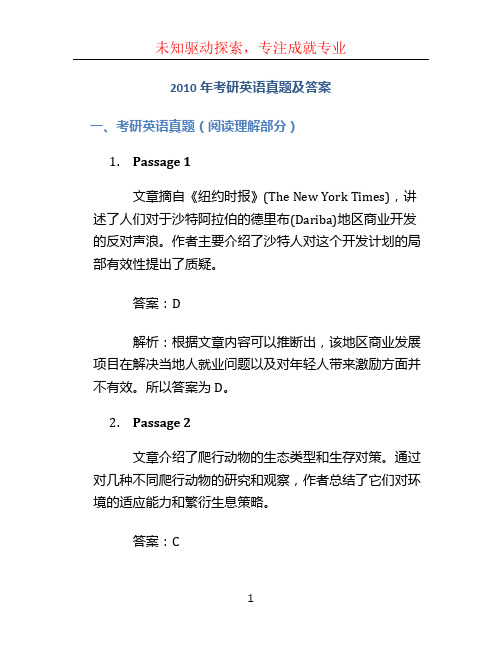
2010年考研英语真题及答案一、考研英语真题(阅读理解部分)1.Passage 1文章摘自《纽约时报》(The New York Times),讲述了人们对于沙特阿拉伯的德里布(Dariba)地区商业开发的反对声浪。
作者主要介绍了沙特人对这个开发计划的局部有效性提出了质疑。
答案:D解析:根据文章内容可以推断出,该地区商业发展项目在解决当地人就业问题以及对年轻人带来激励方面并不有效。
所以答案为D。
2.Passage 2文章介绍了爬行动物的生态类型和生存对策。
通过对几种不同爬行动物的研究和观察,作者总结了它们对环境的适应能力和繁衍生息策略。
答案:C解析:根据文章内容可以得出,某些种类的爬行动物具有在生境发生变化时进行数量调整的能力。
所以答案为C。
3.Passage 3文章介绍了一种新的种植模式,旨在减少对水资源的需求以及提高产量。
作者通过对这种种植模式的实验研究,发现它可以在干旱地区获得较高的产量。
答案:B解析:根据文章内容可以得出,这种新的种植模式通过改变作物的生长方式,减少了对水资源的需求,从而提高了产量。
所以答案为B。
二、答案解析1.Passage 1题目要求解释为什么该地区商业发展项目在解决当地人就业问题方面并不有效。
文章中提到该开发项目只提供了少量工作岗位,远远不够满足就业需求。
所以答案为D。
2.Passage 2题目要求解释某些爬行动物的数量调整能力。
通过文章可以看出,某些爬行动物能够根据其所处环境的变化来调整自身的数量,以适应变化的生境条件。
所以答案为C。
3.Passage 3题目要求解释这种新的种植模式在干旱地区获得高产量的原因。
文章中解释了这种新的种植模式通过改变作物的生长方式,减少了对水资源的需求,从而提高了产量。
所以答案为B。
三、总结本篇文章简要介绍了2010年考研英语阅读理解部分的三篇真题及其答案解析。
通过阅读这些真题及答案解析,可以帮助考生了解考研英语阅读理解题型和解题思路,提高解题能力。
2010年考研英语二阅读及新题型答案解析

2010年考研英语二阅读及新题型答案解析Text 121. In the first paragraph, Damien Hirst's sale was referred to as “a last victory” because ____-。
A. the art market had witnessed a succession of victoriesB. the auctioneer finally got the two pieces at the highest bidsC. Beautiful inside My Head Forever won over all masterpiecesD. it was successfully made just before the world financial crisis33623 037选【D】,因为第一段段尾句As the auctioneer called out bids, in New York one of the oldest banks on Wall Street, Lehman Brothers, filed for bankruptcy. 即雷曼兄弟公司破产。
正门对面22. By saying “spending of any sort became deeply unfashionable”(Line 1-2,Para.3),the author suggests that_____ 。
A. collectors were no longer actively involved in art-market auctionskaoyantjB. people stopped every kind of spending and stayed away from gallerieskaoyantjC. art collection as a fashion had lost its appeal to a great extent业D. works of art in general had gone out of fashion so they were not worth buying业选【A】,本题迷惑选项为C,文章第三段只强调了 collectors stayed away;Sales fell,并没有强调“收藏时尚早在这之前就已经大大降温了”。
2010年考研英语新题型解析(万学海文)
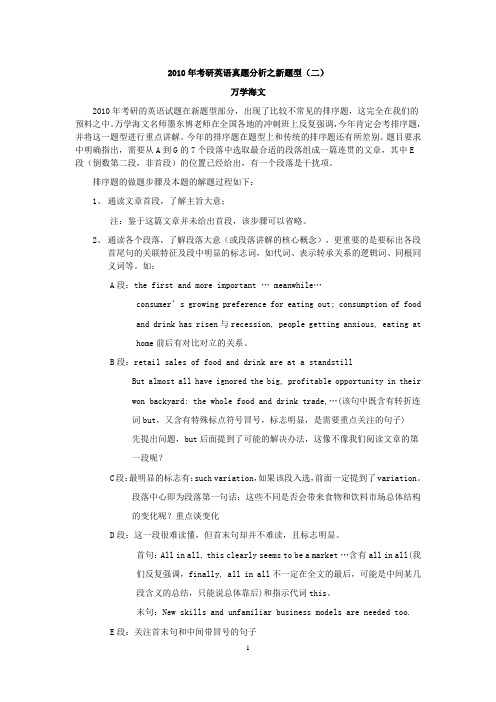
2010年考研英语真题分析之新题型(二)万学海文2010年考研的英语试题在新题型部分,出现了比较不常见的排序题,这完全在我们的预料之中。
万学海文名师墨东博老师在全国各地的冲刺班上反复强调,今年肯定会考排序题,并将这一题型进行重点讲解。
今年的排序题在题型上和传统的排序题还有所差别。
题目要求中明确指出,需要从A到G的7个段落中选取最合适的段落组成一篇连贯的文章,其中E段(倒数第二段,非首段)的位置已经给出,有一个段落是干扰项。
排序题的做题步骤及本题的解题过程如下:1、通读文章首段,了解主旨大意;注:鉴于这篇文章并未给出首段,该步骤可以省略。
2、通读各个段落,了解段落大意(或段落讲解的核心概念),更重要的是要标出各段首尾句的关联特征及段中明显的标志词,如代词、表示转承关系的逻辑词、同根同义词等。
如:A段:the first and more important … meanwhile…consumer’s growing preference for eating out; consumption of food and drink has risen与recession, people getting anxious, eating athome前后有对比对立的关系。
B段:retail sales of food and drink are at a standstillBut almost all have ignored the big, profitable opportunity in theirwon backyard: the whole food and drink trade,…(该句中既含有转折连词but,又含有特殊标点符号冒号,标志明显,是需要重点关注的句子)先提出问题,but后面提到了可能的解决办法,这像不像我们阅读文章的第一段呢?C段:最明显的标志有:such variation,如果该段入选,前面一定提到了variation。
2010年考研英语真题答案及解析
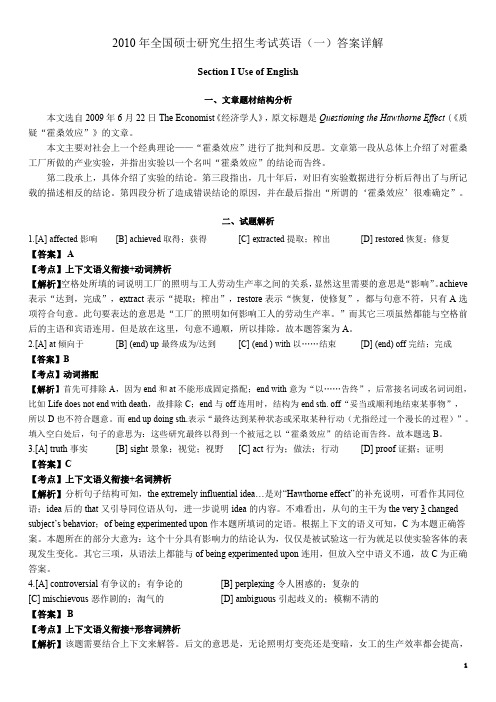
10.[A] about (oneself) 关于自己
[B] for (oneself) 为自己
[C] on (oneself)
[D] by (oneself) 独立地,无人帮助地,独自地
【答案】 D
【考点】上下文语义衔接+固定搭配
【解析】本题考查的是“介词+oneself”的用法。反身代词与不同的介词连用,可表达不同的意思。本题的关键是在
二、试题解析
1.[A] affected 影响 [B] achieved 取得;获得
[C] extracted 提取;榨出
[D] restored 恢复;修复
【答案】 A
【考点】上下文语义衔接+动词辨析
【解析】空格处所填的词说明工厂的照明与工人劳动生产率之间的关系,显然这里需要的意思是“影响”。achieve
表示“达到,完成”,extract 表示“提取;榨出”,restore 表示“恢复,使修复”,都与句意不符,只有 A 选
项符合句意。此句要表达的意思是“工厂的照明如何影响工人的劳动生产率。”而其它三项虽然都能与空格前
后的主语和宾语连用。但是放在这里,句意不通顺,所以排除。故本题答案为 A。
2.[A] at 倾向于
1
因此这个现象是“令人费解的”,只有 perplexing 有此意,而其它三个选项虽然也都可用于修饰空后的 behavior。 然而联系上下文,上下文并没有涉及到妇女们的行为是“有争议的”、“恶作剧的”或“引起歧义的”,故本
题的正确答案是 B。
5.[A] requirements 要求 [B] explanations 解释;说明 [C] accounts 报告;描述 [D] assessments 评定;估价
2010年考研英语新题型解析

2010年考研英语新题型解析万学·海文英语教研中心《全国硕士研究生入学统一考试英语考试大纲解析》中并没有提到对新题型的变化,因此预计2010年的考研英语新题型仍然会继续从三种备选题型中选择(7选5、排序题、选择小标题/观点例证题)。
然而纵观前5年的英语试卷,我们会发现7选5新题型是出现频率最高的,05年 06年 08年和 09年都是采用了这种题型。
究其原因主要在于与其它两种题型相比较,7选5的难度比较适中。
选择小标题/观点例证题相对来说比较容易,因为这种题型多是考察学生对文章段落的总结概括,或是对某一中心标题的进行阐述、找例证的能力。
学生可以根据段落所提供的信息做出选择。
而比较而言,排序题就有些难度了,因为在做这种题的时候,一旦考生选错了一个,那么就意味着另外一个也会是错误的,甚至会出现局部排列正确而全军覆没的现象。
但是这不是说这两种题型就不会考到,考生还是应该在平时的复习中对其加以一定的重视。
下面我们主要围绕7选5题型来跟大家谈一些方法和技巧。
一、7选5题型的基本命题形式:这种题型的命题形式是给考生一篇字数在500-600单词的短文,出题者有目的地在文章中去除5处信息,形成5处信息空缺,提供总共6-7个备选选项(待选信息),要求考生从6-7个选项中选出5个合适的选项对应地填入原文中的5处空缺,从而将原文恢复成一篇完整的文章。
空缺可能会出现在一个段落的首、尾或者中间部分也可能会空缺整个段落。
二、解题步骤:1. 细读首尾段,抓住主题。
不必要先浏览文章,因为文章缺乏信息,内容不完整。
一来浪费时间效果不好,二来容易被弄糊涂。
相反,由于选项是要填入空缺处的目标,这样有了对目标的把握,就可以“以目标为导向的”去阅读文章。
2. 浏览选项,把握每一个选项主题的同时划出关键词、主题词。
标出人称代词,指示代词,连接词,数词,不定冠词以及定冠词等常用来衔接文章的词语。
另外还要注意选项中的主题词,这些主题词的词性多以名词、动词为特点,尤其要注意其中的专属名词和标志词。
考研英语2010年真题新题型段落排序题解析与答案
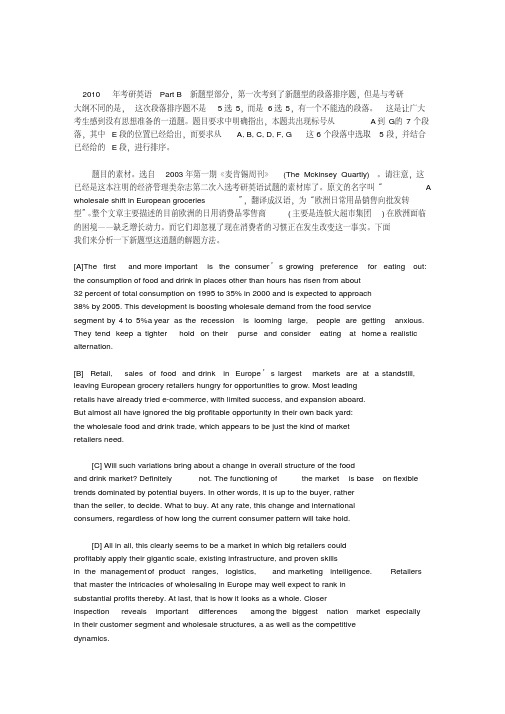
2010年考研英语Part B新题型部分,第一次考到了新题型的段落排序题,但是与考研大纲不同的是,这次段落排序题不是5选5,而是6选5,有一个不能选的段落。
这是让广大考生感到没有思想准备的一道题。
题目要求中明确指出,本题共出现标号从A到G的7个段落,其中E段的位置已经给出,而要求从A, B, C, D, F, G这6个段落中选取5段,并结合已经给的E段,进行排序。
题目的素材。
选自2003年第一期《麦肯锡周刊》(The Mckinsey Quartly)。
请注意,这已经是这本注明的经济管理类杂志第二次入选考研英语试题的素材库了。
原文的名字叫“ A wholesale shift in European groceries”,翻译成汉语,为“欧洲日常用品销售向批发转型”。
整个文章主要描述的目前欧洲的日用消费品零售商(主要是连锁大超市集团)在欧洲面临的困境——缺乏增长动力。
而它们却忽视了现在消费者的习惯正在发生改变这一事实。
下面我们来分析一下新题型这道题的解题方法。
[A]The first and more important is the consumer’s growing preference for eating out: the consumption of food and drink in places other than hours has risen from about32 percent of total consumption on 1995 to 35% in 2000 and is expected to approach38% by 2005. This development is boosting wholesale demand from the food servicesegment by 4 to 5% a year as the recession is looming large, people are getting anxious. They tend keep a tighter hold on their purse and consider eating at home a realistic alternation.[B] Retail, sales of food and drink in Europe’s largest markets are at a standstill, leaving European grocery retailers hungry for opportunities to grow. Most leadingretails have already tried e-commerce, with limited success, and expansion aboard.But almost all have ignored the big profitable opportunity in their own back yard:the wholesale food and drink trade, which appears to be just the kind of marketretailers need.[C] Will such variations bring about a change in overall structure of the foodand drink market? Definitely not. The functioning of the market is base on flexible trends dominated by potential buyers. In other words, it is up to the buyer, ratherthan the seller, to decide. What to buy. At any rate, this change and internationalconsumers, regardless of how long the current consumer pattern will take hold.[D] All in all, this clearly seems to be a market in which big retailers couldprofitably apply their gigantic scale, existing infrastructure, and proven skillsin the management of product ranges, logistics, and marketing intelligence. Retailers that master the intricacies of wholesaling in Europe may well expect to rank insubstantial profits thereby. At last, that is how it looks as a whole. Closerinspection reveals important differences among the biggest nation market especiallyin their customer segment and wholesale structures, a as well as the competitivedynamics.[E] Despite variations in detail, wholesale markets in the countries that havebeen closely examined---France, Germany—are made out of the same building block. Demand mainly from two sources: in dependent mom—and –pop grocery stores which, unlike large retail chains, are too small to buy straight when they don’t eat at home. Such food service operators, but most of these businesses are known in the trade as “horeca”:hotels, restaurant and cafes. Overall, Europe’s wholesale market for food and drink is growing at the same sluggish pace as the retail market, but thefigure when assed together, mask too opposing trends.[F] For example, wholesale food and drink sales came to $268 billion in France, Germany, Spain, America in 2000 --- more than 40 percent of retail sales. Moreover, average overall margins are higher in wholesale than in retail ; wholesale demandfrom the food service sector is growing quickly as more Europeans eat out moreoften ;and in the competitive dynamics of this fragmented industry are at last manit feasible for wholesalers to consolidate.[G] However, none of these requirements should deter large retailers land even some large food producers and existing wholesalers, from trying their hand, foe those that master the intricacies of wholesaling in Europe stand to reap considerable gains.解题步骤与思路:一.归纳6个选项的段落大意,同时注意两个选项之间的联系。
- 1、下载文档前请自行甄别文档内容的完整性,平台不提供额外的编辑、内容补充、找答案等附加服务。
- 2、"仅部分预览"的文档,不可在线预览部分如存在完整性等问题,可反馈申请退款(可完整预览的文档不适用该条件!)。
- 3、如文档侵犯您的权益,请联系客服反馈,我们会尽快为您处理(人工客服工作时间:9:00-18:30)。
[F] For example, wholesale food and drink sales came to $268 billion in France, Germany, Spain, America in 2000 --- more than 40 percent of retail sales. Moreover, average overall margins are higher in wholesale than in retail ; wholesale demand from the food service sector is growing quickly as more Europeans eat out more often ;and in the competitive dynamics of this fragmented industry are at last man it feasible for wholesalers to consolidate.
六. 参考答案:41---45 【B】【F】【D】【G】【A】。
[E] Despite variations in detail, wholesale markets in the countries that have been closely examined---France, Germany—are made out of the same building block. Demand mainly from two sources: in dependent mom—and –pop grocery stores which, unlike large retail chains, are too small to buy straight when they don’t eat at home. Such food service operators, but most of these businesses are known in the trade as “horeca”:hotels, restaurant and cafes. Overall, Europe’s wholesale market for food and drink is growing at the same sluggish pace as the retail market, but the figure when assed together, mask too opposing trends.
[C] Will such variations bring about a change in overall structure of the food and drink market? Definitely not. The functioning of the market is base on flexible trends dominated by potential buyers. In other words, it is up to the buyer, rather than the seller, to decide. What to buy. At any rate, this change and international consumers, regardless of how long the current consumer pattern will take hold.
[D] All in all, this clearly seems to be a market in which big retailers could profitably apply their gigantic scale, existing infrastructure, and proven skills in the management of product ranges, logistics, and marketing intelligence. Retailers that master the intricacies of wholesaling in Europe may well expect to rank in substantial profits thereby. At last, that is how it looks as a whole. Closer inspection reveals important differences among the biggest nation market especially in their customer segment and wholesale structures, a as well as the competitive dynamics.
[G] However, none of these requirements should deter large retailers land even some large food producers and existing wholesalers, from trying their hand, foe those that master the intricacies of wholesaling in Europe stand to reap considerable gains.
[A]The first and more important is the consumer’s growing preference for eating out: the consumption of food and drink in places other than hours has risen from about 32 percent of total consumption on 1995 to 35% in 2000 and is expected to approach 38% by 2005. This development is boosting wholesale demand from the food service segment by 4 to 5% a year as the recession is looming large, people are getting anxious. They tend keep a tighter hold on their purse and consider eating at home a realistic alternation.
解题步骤与思路:
一.归纳6个选项的段落大意,同时注意两个选项之间的联系。通过阅读阅读选项【B】,我们归纳出其中心意思是:欧洲市场的日用品零售市场已经停止,因此大部分零售商已经尝试电子商务,但是几乎所有的零售商都无视了日用品的批发业务,认为它应该是一个大的,赚钱的机会。同时我们发现,【F】选项是在具体的说明批发业务给法国,德国,意大利等国家带来的巨大利益,这两个选项之间的关系属于典型的观点+例证的逻辑关系,所以我们可以选定应该是【B】,然后是[F]。【B】选项的末句和选项【F】有词汇上照应,这连个选项之间都出现了wholesale food and drink这几个关键词。
四.选项【C】的主题是谈到市场结构变化的问题,也提到影响市场运转的因素。但是我们发现没有出现与前面6段主题一致的中心词汇,比如;retail, wholesale, food and drink等,它的最大的干扰来自“market”这个词语,只可惜不是段落的中心词汇。
五.现在重要的是BFDG的顺序问题。如果一旦错误,就会导致四道题全错。我们发现选项[B]的末句说大部分大型的零售商无视了wholesale的重要性,即没有充分意识到它的重要性,属于典型的首开wholesale food and drink话题的写作方式,而且在接下来的段落里都是围绕wholesale这个话题展开的,因此第一段应该选[B]。
2010年考研英语Part B新题型部分,第一次考到了新题型的段落排序题,但是与考研大纲不同的是,这次段落排序题不是5选5,而是6选5,有一个不能选的段落。这是让广大考生感到没有思想准备的一道题。题目要求中明确指出,本题共出现标号从A到G的7个段落,其中E段的位置已经给出,而要求从A, B, C, D, F, G这6个段落中选取5段,并结合已经给的E段,进行排序。
[B] Retail, sales of food and drink in Europe’s largest markets are at a standstill, leaving European grocery retailers hungry for opportunities to grow. Most leading retails have already tried e-commerce, with limited success, and expansion aboard. But almost all have ignored the big profitable opportunity in their own back yard: the wholesale food and drink trade, which appears to be just the kind of market retailers need.
题目的素材。选自2003年第一期《麦肯锡周刊》(The Mckinsey Quartly)。请注意,这已经是这本注明的经济管理类杂志第二次入选考研英语试题的素材库了。原文的名字叫“A wholesale shift in European groceries”,翻译成汉语,为“欧洲日常用品销售向批发转型”。整个文章主要描述的目前欧洲的日用消费品零售商(主要是连锁大超市集团)在欧洲面临的困境——缺乏增长动力。而它们却忽视了现在消费者的习惯正在发生改变这一事实。下面我们来分析一下新题型这道题的解题方法。
